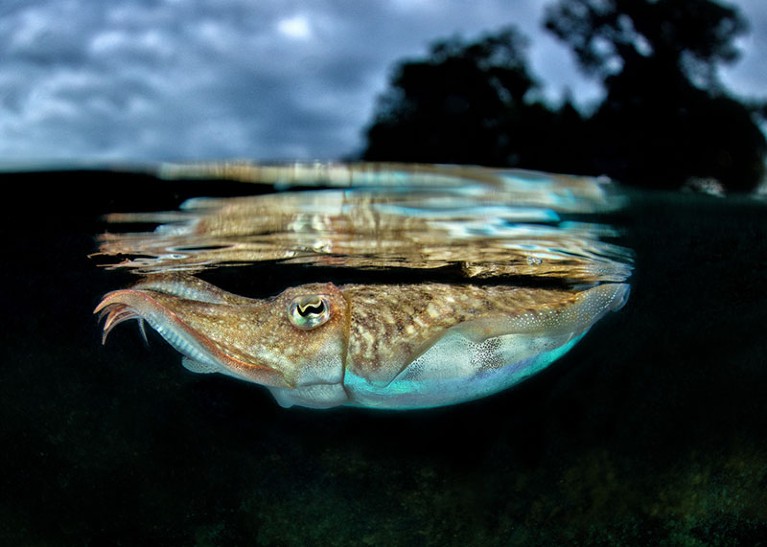Hello Nature readers, welcome to your essential daily briefing. You can also sign up to get it free in your inbox.

Cuttlefish are masters of quick-change camouflage, thanks to skin cells that act as coloured pixels.Credit: Pasquale Vassallo/Getty
Cuttlefish wear their thoughts on their skin
Researchers have discovered how to infer a cuttlefish’s brain activity by tracking its ever-changing camouflage patterns. The creature’s colour-changing skin cells are controlled directly by neurons that extend from the brain. The ability to see the inner workings of the cuttlefish’s brain reflected on its skin — without cutting the animal open, attaching electrodes to it or training it to behave in a certain way — could also help researchers to understand the links between brain activity and behaviour.
Nature | 4 min read (plus a great video)
$3-million prize for revolutionary microscopy
A picture might be worth a thousand words, but inventing a technique to take nanoscale pictures is worth this year’s US$3 million Breakthrough Prize. Biophysicist Xiaowei Zhuang was the lead inventor of a microscopy technique that was one of the first to break a fundamental resolution limit of conventional light microscopes. It is now widely used by biologists to reveal hidden structures in cells. Other winners of science’s most lucrative prize included a pair of researchers who predicted an exotic material known as a topological insulator, and a group that developed a therapy to silence the gene that causes neurodegenerative spinal muscular atrophy in children.
WHO: Ebola outbreak not an international emergency
The World Health Organization (WHO) says the latest Ebola outbreak in the northeast of the Democratic Republic of the Congo (DRC) is extremely worrying, but the agency is optimistic it can be brought under control relatively quickly, given the country’s long experience in dealing with these outbreaks. This is the DRC’s tenth Ebola outbreak since 1976. So far, there have been 185 confirmed cases, including 139 deaths.
Dandelion seeds fly using previously unknown physics
Dandelion seeds take to the skies using a method of flight never before seen in nature. It’s based on a previously unknown kind of vortex, and the amount of open space between the seeds’ stalks seems to be the key to its stability. This type of flight might even be common in the plant and animal kingdoms, now that we know where to look.
“Lesser” institutions make grant money go further
Top institutions deliver much less for their grant money than less-prestigious ones, yet they get a disproportionate share of funding. So says an analysis of grants by the largest source of funding for biomedical research in the world, the US National Institutes of Health (NIH), from 2006 to 2015. The study found that less-prestigious institutions produced 65% more publications and had a 35% higher citation impact per dollar of funding than the top dogs, based on their positions in the 2016 US News & World Report Best Medical Schools: Research rankings. The research was done by biomedical researcher Wayne Wahls, whose own work is supported by an NIH grant.
FEATURES & OPINION
The biggest pandemic risk? Fake news
The next major outbreak will not be due to a lack of preventive technologies, argues risk researcher Heidi Larson. Instead, it will be the viral misinformation that is undermining trust in vaccines crucial to public health. She describes her project to categorize and counter fake news that can kill.
The top science-policy issue in every US state
Voters in the United States are facing “the most important election of our lifetime”, says conservation-policy specialist Bill Holland. Popular Science offers a state-by-state breakdown of policies that will have the most environmental, technological or scientific impact. From rural health care in Texas to water quality in Alabama, this is a handy, non-partisan list of issues that will decide “to some degree how we live for decades to come”.
Popular Science | 42 min read (but you can jump to any state)
Geneticists recoil from the racists who tout them
Geneticists are struggling with how to respond as they see their research twisted to support racist claims. Some scientists try to set the record straight with public rebuttals or caveats on their presentations and websites. Some prefer to keep out of a debate that thrives in the foulest corners of the Internet, or hope that if they ignore it, it will just go away. For others, the challenge of debunking scientific racism is simply too great: “There are often many layers of uncertainties in our findings,” said human-genetics researcher Anna Di Rienzo. “Being able to communicate that level of uncertainty to a public that often just sees things in black and white is very, very difficult.”
